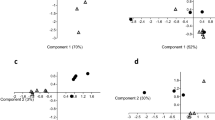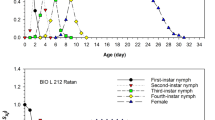Abstract
Levels of soluble protein and carbohydrate (raffinose, sucrose, glucose, and fructose) in leaves from a selection of plant species were measured to determine if a relationship existed between these nutrients and infestation by Frankliniella occidentalis and Heliothrips haemorrhoidalis. Most species of host plant examined contained a higher proportion of protein than carbohydrates, and overall, leaves from species of plants that supported populations of thrips had greater levels of protein than leaves from nonhost species. New leaves and flowers that supported F. occidentalis contained high levels of carbohydrate and protein. The quantity of protein in leaves at the top of the tree, Peumus boldus, was greater than in leaves from lower levels, and the amount of feeding damage accrued by H. haemorrhoidalis was greater on the upper foliage than lower foliage. Oviposition by H. haemorrhoidalis was positively correlated to levels of protein in host plants but not to levels of carbohydrates. Overall, levels of soluble protein in plants influenced their susceptibility to thrips more than levels of carbohydrates.
Similar content being viewed by others
REFERENCES
Bernays, E. A. and Chapman, R. F. 1994. Chemicals in plants, pp. 14–60, in Host-Plant Selection by Phytophagous Insects. Chapman and Hall, London, United Kingdom.
Bernays, E. A. and Simpson, S. J. 1982. Control of food intake. Adv. Insect Physiol. 16:59–118.
Blaney, W. M. and Simmonds, M. J. S. (1988). Food selection in adults and larvae of three species of Lepidoptera: a behavioural and electrophysiological study. Entomol. Exp. Appl. 49:111–121.
Boyce, A. M. and Persing, C. O. 1939. Tartar emetic in the control of citrus thrips on lemons. J. Econ. Entomol. 32:153.
Brown, R. E., Jarvis, K. L., and Hyland, K. J. 1989. Protein measurement using bicinchoninic acid: elimination of interfering substances. Anal. Biochem. 180:136–139.
Derridj, S., Wu, B. R., Stammitti, L., Garrec, J. P., and Derrien, A. 1996. Chemicals on the leaf surface: information about the plant available to insects. Entomol. Exp. Appl. 80:197–201.
Fowler, J., Cohen, L., and Jarvis, P. 1999. Comparing averages, pp. 165–178, in Practical Statistics for Field Biologists. Wiley, London, United Kingdom.
Gonzalez, J. A., Roldan, A., Gallardo, M., Escudero, T., and Prado, F. E. 1989. Quantitative determinations of chemical compounds with nutritional value from Inca crops: Chenopodium quinoa ('quinoa'). Plant Food Hum. Nutr. 39:331–337.
Karowe, D. N. and Martin, M. M. 1989. The effects of quantity and quality of diet nitrogen on growth, efficiency of food utilization, nitrogen budget and metabolic rate of fifth-instar Spodotera eridania larvae (Lepidoptera: Noctuidae). J. Insect Physiol. 35:699–708.
Mattson, W. J. 1980. Herbivory in relation to plant nitrogen content. Annu. Rev. Ecol. Syst. 102:391–403.
MCneill, S. and Southwood, T. R. E. 1978. Role of nitrogen in the development of insect-plant relationships, pp. 77–98, in J. B. Harbourne (ed.). Biochemical Aspects of Plant and Animal Coevolution. Academic Press, New York.
Morse, J. G. 1995. Prospects for IPM of citrus thrips in California, pp. 371–379, in B. L. Parker, M. Skinner, and T. Lewis (eds.). Thrips Biology and Management. Plenum Press, New York.
Ohgushi, T. 1992. Resource limitation on insect herbivore populations, pp. 199–241, in T. Hunter, T. Ohgushi, and P. W. Price (eds.). Effects of Resource Distribution on Animal-Plant Interactions. Academic Press, San Diego, California.
Parrella, M. P. 1995. IPM-approaches and prospects, pp. 357–363, in B. L. Parker, M. Skinner, and T. Lewis (eds.). Thrips Biology and Management. Plenum Press, New York.
Pierce Chemical. 1996. BCA protein assay reagent kit. Instruction 23225. Pierce Chemical Company, Chicago, Illinois.
Schoonhoven, L. M., Jermy, T., and Loon Van, J. J. A. 1998. Plants as insect food: not the ideal, pp. 83–120, in Insect-Plant Biology, Chapman and Hall, London, United Kingdom.
Schoonhoven, L. M., Jermy, T., and Loon Van, J. J. A. 1998b. Host plant selection: when to accept a plant, pp. 155–193, in Insect-Plant Biology, Chapman and Hall, London, United Kingdom.
Scott Brown, A. S. 2002. Interactions of thrips and their control agents on host plants within a glasshouse containing a diverse collection of plant species. PhD. Birkbeck College, University of London, London, United Kingdom.
Scott Brown, A. S., Simmonds, M. S. J., and Blaney, W. M. 1999. Influence of host plants on the predation of thrips by Neoseiulus cucumeris, Iphiseius degenerans and Orius laevigatus. Entomol. Exp. Appl. 92:283–288.
Slansky, F. 1993. Nutritional Ecology: The fundamental quest for nutrients, pp. 29–91, in N. E. Stamp and T. M. Casey (eds.). Caterpillar—Ecology and Evolutionary Constraints on Foraging. Chapman and Hall, New York.
Smith, P. K., Krohn, R. I., Hermanson, G. T., Mallia, A. K., Gartner, F. H., Provenzano, M. D., Fujimoto, E. K., Goeke, N. M., Olson, B. J., and Klenk, D. C. 1985. Measurement of protein using bicinchoninic acid. Anal. Biochem. 150:76–85.
Strong, D. R., Lawton, J. H., and Southwood, T. R. E. 1984. Insects on plants: community patterns and mechanisms. Blackwell Scientific Publications, Oxford, United Kingdom.
Trichilo, P. J. and Leigh, T. F. 1988. Influence of resource quality on the reproductive fitness of flower thrips (Thysanoptera: Thripidae). Ann. Entomol. Soc. Am. 81:64–70.
Ullman, D. E., Cho, J. J., Mau, R. F. L., Hunter, W. B., Westcot, D. M., and Custer, D.M. 1992. Thrips-tomato spotted wilt virus interactions: morphological, behavioural and cellular components influencing thrips transmission. Adv. Dis. Vector Res. 9:195–240.
Author information
Authors and Affiliations
Corresponding author
Rights and permissions
About this article
Cite this article
Scott Brown, A.S., Simmonds, M.S.J. & Blaney, W.M. Relationship Between Nutritional Composition of Plant Species and Infestation Levels of Thrips. J Chem Ecol 28, 2399–2409 (2002). https://doi.org/10.1023/A:1021471732625
Published:
Issue Date:
DOI: https://doi.org/10.1023/A:1021471732625




